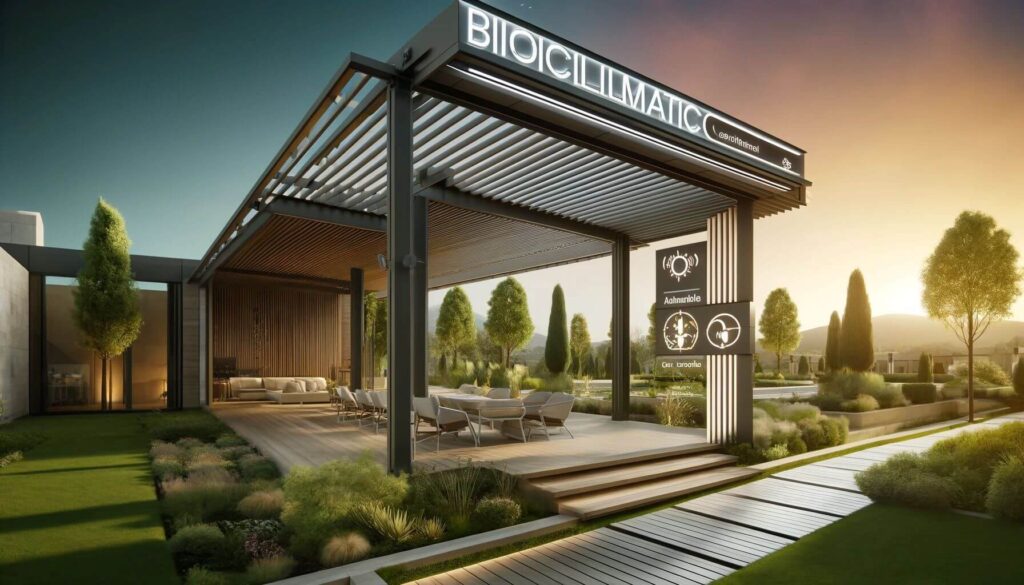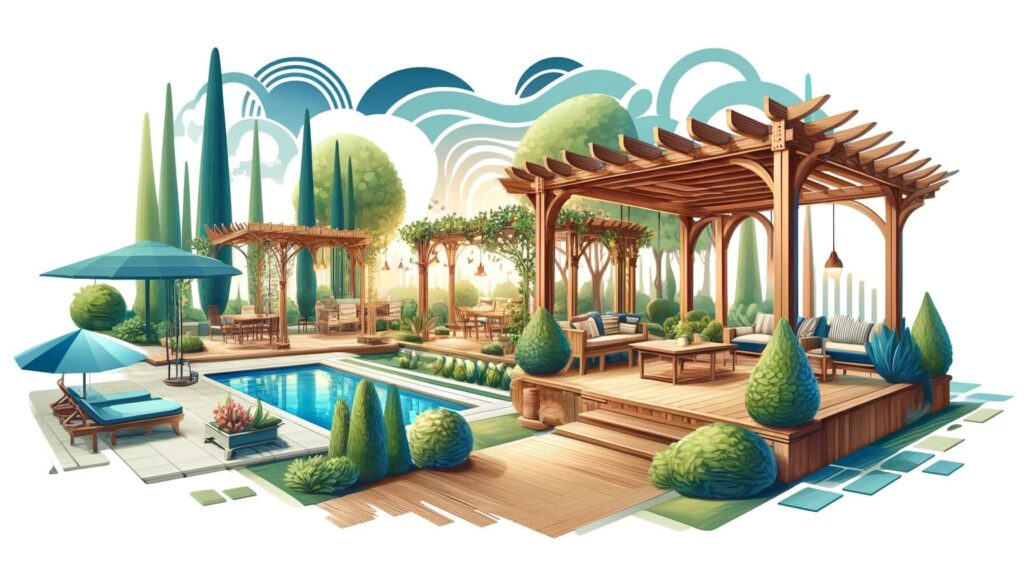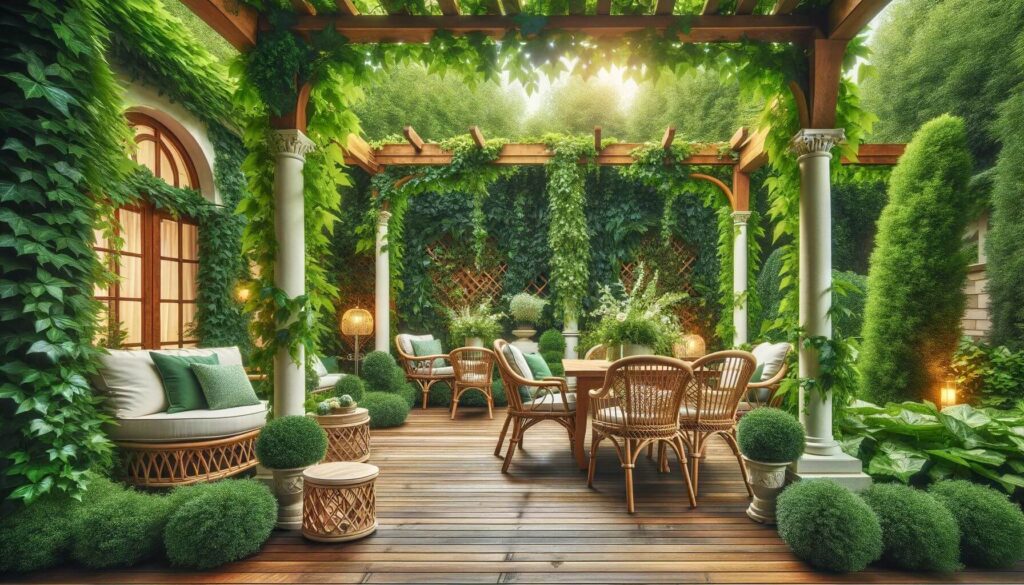
Creating outdoor living spaces that harmonize with nature not only enhances our personal well-being but also contributes positively to the environment. Among these spaces, pergolas stand out as versatile structures that offer shade, beauty, and a perfect spot for relaxation or entertainment in our gardens. This article delves into the essence of constructing a pergola not just as an aesthetic addition to your home but as a testament to sustainable living practices.
In recent years, the emphasis on sustainable living has transcended indoor spaces, extending into the realms of our outdoor environments. Gardens, patios, and backyards are being transformed into eco-friendly havens that promote a harmonious balance with nature. A cornerstone of such initiatives is the construction of pergolas using environmentally responsible methods and materials. To treat an eco-friendly pergola environment you should know the importance of sustainability in outdoor living spaces. So you should know the process of making conscientious choices that benefit both the planet and their personal space.
Sustainable Materials for Pergola Construction

Choosing Sustainable Wood
Wood is a classic choice for pergola construction, offering natural beauty and a timeless appeal. However, the source and type of wood are crucial factors in determining its environmental impact. Options like bamboo, reclaimed wood, or Forest Stewardship Council (FSC)-certified timber are excellent choices for those looking to minimize their ecological footprint. Bamboo, for instance, is highly renewable due to its fast growth rate, while reclaimed wood repurposes existing materials, and FSC certification ensures that the timber is harvested in an environmentally responsible, socially beneficial, and economically viable manner.
The Benefits of Using Recycled Metal and Plastic
Diversifying materials in pergola construction can lead to more sustainable outcomes. Recycled metals and plastics offer durability and resilience, with the added advantage of reducing waste in landfills. Utilizing these materials not only contributes to a more sustainable pergola but also promotes a circular economy, where resources are reused and recycled, minimizing the need for virgin materials and reducing the overall environmental impact.
Exploring Alternative Materials
Innovation in eco-friendly materials has introduced a variety of alternatives for pergola construction. Composite decking, made from a blend of wood fibers and recycled plastics, provides the aesthetic appeal of wood without the maintenance or environmental drawbacks. Cork, another sustainable choice, is not only lightweight and rot-resistant but also renewable, as its harvest does not harm the cork oak tree. These alternatives, along with other eco-friendly innovations, are paving the way for more sustainable outdoor living spaces that do not compromise on beauty or functionality.
Green Roofing and Shade Options

The integration of green roofing and sustainable shade options not only enhances the aesthetic appeal of pergolas but also contributes significantly to environmental conservation. Let’s see how these features can transform your pergola into a beacon of sustainability.
Installing a Green Roof
A green roof, or a living roof, on your pergola can serve as a mini-habitat for local flora and fauna, thereby promoting biodiversity. Additionally, it provides excellent insulation, keeping the area beneath cooler in summer and warmer in winter, which in turn reduces the energy required for heating and cooling your home. This symbiosis between form and function exemplifies the core principles of sustainable living.
Selecting Eco-Friendly Roofing Materials
The choice of roofing materials greatly influences the environmental footprint of your pergola. Options such as recycled tiles offer a way to repurpose materials that would otherwise end up in landfills. Incorporating solar panels can harness solar energy to power your outdoor lighting and other electrical needs, further reducing your reliance on non-renewable energy sources. Sustainable shade cloths, made from eco-friendly materials, provide a breathable covering that protects against the sun while minimizing environmental impact.
The Role of Natural Vines and Plant Cover
Incorporating natural vines and plant cover is a visually stunning and environmentally friendly way to enhance the shade provided by your pergola. This living canopy not only offers a cooler, shaded area but also contributes to local ecology by supporting biodiversity. Climbing plants such as jasmine, wisteria, or grapevines can turn your pergola into a lush, green oasis, improving air quality and offering a habitat for birds and beneficial insects.
Energy-Efficient Lighting and Heating
Adopting energy-efficient solutions for lighting and heating your pergola ensures that your outdoor living space remains comfortable without compromising on sustainability.
Solar-Powered Lighting Options
Solar-powered lights are an excellent choice for pergolas, providing ample illumination after sundown without the need for electrical wiring or the consumption of fossil fuels. These lights harness the power of the sun during the day to offer a soft, ambient glow in the evenings, creating a cozy atmosphere that is both eco-friendly and cost-effective.
Eco-Friendly Heating Solutions
For cooler evenings, eco-friendly heating solutions such as infrared heaters or fire pits that utilize sustainable fuels can provide warmth without the high environmental impact associated with traditional heating methods. Infrared heaters, for example, deliver direct warmth to people and objects without heating the air, resulting in efficient and effective outdoor heating. Fire pits, on the other hand, can be fueled by eco-friendly briquettes or sustainably sourced wood, offering warmth and a focal point for social gatherings.
Tips for Maximizing Natural Light and Warmth
Designing your pergola to maximize the use of natural light and warmth can significantly reduce the need for artificial lighting and heating. Orienting the pergola to take advantage of the sun’s path, using reflective surfaces to enhance natural light, and selecting materials that retain heat can all contribute to a more energy-efficient outdoor space.
By thoughtfully integrating these green roofing, shade options, and energy-efficient solutions, your pergola can serve as a model of sustainability, providing a comfortable and eco-friendly outdoor retreat.
Water Conservation Techniques

In the quest to create a sustainable pergola environment, water conservation stands as a critical component. Employing efficient water use strategies not only supports the health of your pergola garden but also contributes to the broader goal of environmental stewardship. Let’s explore some effective techniques.
Rainwater Harvesting Systems
Installing a rainwater harvesting system is a fantastic way to utilize natural precipitation for irrigating your pergola gardens. By collecting runoff from rooftops and storing it in barrels or tanks, you can create a reserve of untreated, chemical-free water. This method reduces reliance on municipal water supplies, saves on water bills, and provides your plants with high-quality hydration.
Drip Irrigation and Other Water-Efficient Solutions
Drip irrigation systems deliver water directly to the base of plants, minimizing evaporation and runoff. This targeted approach ensures that water is used efficiently, benefiting your plants while conserving this precious resource. Other water-efficient solutions include soaker hoses and the timely watering of plants, ideally during the cooler parts of the day, to further reduce water wastage.
Choosing Drought-Resistant Plants
Incorporating drought-resistant plants and flowers into your pergola’s garden design can significantly cut down on water usage. Species that are native to your region or adapted to arid conditions require less water and are more resilient to heat, reducing the need for frequent watering. This strategy not only conserves water but also promotes local biodiversity.
Furniture and Decor from Sustainable Sources
The furniture and decor you choose play a pivotal role in defining the sustainability of your pergola space. Opting for items made from eco-friendly materials not only reduces environmental impact but also adds a unique charm to your outdoor oasis.
Selecting Outdoor Furniture
When selecting outdoor furniture, consider pieces made from recycled or sustainable materials. Furniture crafted from reclaimed wood, recycled plastic, or responsibly sourced metal can offer durability and style without depleting natural resources. Brands that prioritize sustainability in their manufacturing processes are increasingly available, providing stylish, eco-conscious options for your pergola.
DIY Decor Ideas: Upcycling Items
Embracing DIY decor and upcycling projects can transform everyday items into unique pergola decorations. Old jars can become lanterns, pallets can be repurposed into seating, and unused containers can find new life as planters. These creative endeavors not only reduce waste but also allow you to infuse personal touches into your outdoor space.
The Importance of Non-Toxic, Eco-Friendly Paints and Stains
Finishing your pergola and its furnishings with non-toxic, eco-friendly paints and stains is crucial for maintaining a healthy, sustainable environment. These products, devoid of harmful chemicals, safeguard the air quality and the health of your garden. They also offer durability and weather resistance, ensuring your pergola remains a haven of sustainability for years to come.
By integrating these water conservation techniques and choosing furniture and decor from sustainable sources, you can create a pergola environment that is not only beautiful and functional but also profoundly respectful of the planet. This commitment to sustainability ensures that your outdoor space will be enjoyed by generations to come, serving as a testament to responsible, eco-friendly living.
Encouraging Wildlife and Biodiversity

A crucial aspect of creating a sustainable pergola environment is encouraging local wildlife and promoting biodiversity. This not only enriches your garden ecosystem but also plays a part in preserving the natural balance in your local area. Here’s how you can make your pergola a haven for wildlife.
Planting Native Species
Incorporating native plants into your pergola’s surroundings is one of the most effective ways to attract pollinators, such as bees and butterflies, as well as birds. Native species have evolved alongside local wildlife and are inherently more attractive to these creatures. They provide essential food and nectar sources, nesting materials, and natural shelter, supporting a vibrant ecosystem right in your backyard.
Creating Habitats
Enhancing your pergola with features like birdhouses, bee hotels, and butterfly gardens not only adds aesthetic value but also creates vital habitats. These structures offer safe places for wildlife to nest, breed, and thrive. By fostering a welcoming environment for these creatures, you contribute to their conservation and the health of the local ecosystem.
The Benefits of Maintaining a Chemical-Free Pergola Environment
Avoiding the use of chemical pesticides and fertilizers in and around your pergola is paramount to protecting the visiting wildlife. Chemicals can be harmful to pollinators, birds, and beneficial insects, disrupting the natural balance. A chemical-free pergola garden ensures that your little slice of nature remains a safe and healthy sanctuary for all its inhabitants.
What to Know about Sustainable Pergola Environment
Creating an eco-friendly pergola environment is a journey towards sustainability that extends beyond aesthetic enhancement. It involves making conscientious choices about materials, water conservation, energy use, and the promotion of biodiversity. By embracing sustainable practices, you contribute to the well-being of the planet and foster a deeper connection with nature in your outdoor living space.
Let this article serve as encouragement to begin with small, deliberate steps towards transforming your pergola into an eco-friendly oasis. Whether it’s choosing sustainable building materials, conserving water, encouraging wildlife, or adopting eco-friendly furnishings, each action you take is a step towards a more sustainable future.



